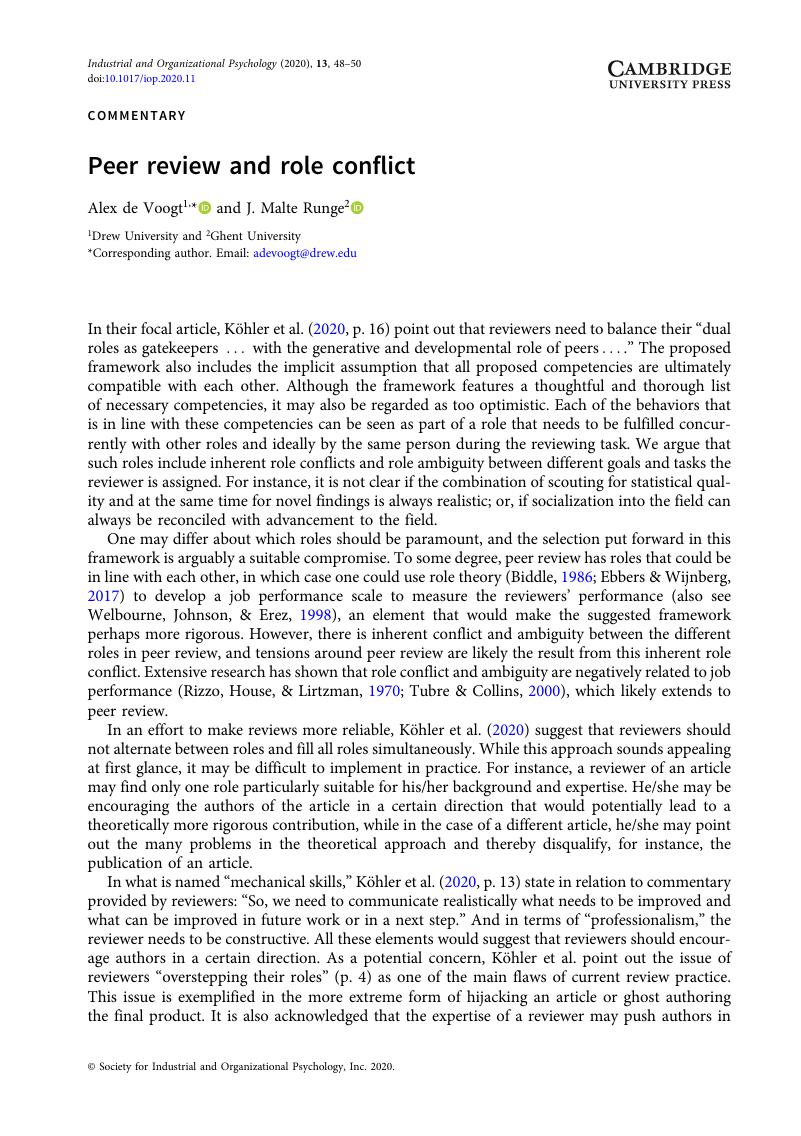No CrossRef data available.
Article contents
Peer review and role conflict
Published online by Cambridge University Press: 01 May 2020
Abstract
An abstract is not available for this content so a preview has been provided. Please use the Get access link above for information on how to access this content.

- Type
- Commentaries
- Information
- Copyright
- © Society for Industrial and Organizational Psychology, Inc. 2020
References
Ashforth, B. E., & Saks, A. M. (1996). Socialization tactics: Longitudinal effects on newcomer adjustment. Academy of Management Journal, 39(1), 149–178. doi: 10.2307/256634Google Scholar
Biddle, B. J. (1986). Recent developments in role theory. Annual Review of Sociology, 12(1), 67–92. doi: 10.1146/annurev.so.12.080186.000435CrossRefGoogle Scholar
Ebbers, J. J., & Wijnberg, N. M. (2017). Betwixt and between: Role conflict, role ambiguity and role definition in project-based dual-leadership structures. Human Relations, 70(11), 1342–1365. doi: 10.1177/0018726717692852CrossRefGoogle ScholarPubMed
Floyd, S. W., & Lane, P. J. (2000). Strategizing throughout the organization: Managing role conflict in strategic renewal. The Academy of Management Review, 25(1), 154–177. doi: 10.2307/259268CrossRefGoogle Scholar
Köhler, T., González‐Morales, M. G., Banks, G. C., O’Boyle, E. H., Allen, J. A., Sinha, R., … Gulick, L. M. V. (2020). Supporting robust, rigorous, and reliable reviewing as the cornerstone of our profession: Introducing a competency framework for peer review. Industrial and Organizational Psychology: Perspectives on Science and Practice, 13(1), 1–27.CrossRefGoogle Scholar
Kuhn, T. S. (1977). The essential tension: Selected studies in scientific tradition. Chicago: University of Chicago Press.CrossRefGoogle Scholar
Rizzo, J. R., House, R. J., & Lirtzman, S. I. (1970). Role conflict and ambiguity in complex organizations. Administrative Science Quarterly, 15(2), 150–163. doi: 10.2307/2391486CrossRefGoogle Scholar
Tubre, T. C., & Collins, J. M. (2000). Jackson and Schuler (1985) revisited: A meta-analysis of the relationships between role ambiguity, role conflict, and job performance. Journal of Management, 26(1), 155–169. doi: 10.1177/014920630002600104CrossRefGoogle Scholar
Welbourne, T. M., Johnson, D. E., & Erez, A. (1998). The role-based performance scale: Validity analysis of a theory-based measure. Academy of Management Journal, 41(5), 540–555. doi: 10.2307/256941Google Scholar




